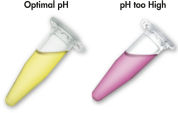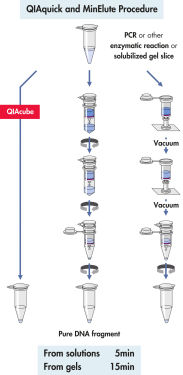QIAquick Gel Extraction Kit – Purification du gel
Pour l’extraction sur gel/le nettoyage d’ADN de 10 µg maximum (70 pb à 10 kb) à partir de milieux gélifiés ou de réactions enzymatiques
Pour l’extraction sur gel/le nettoyage d’ADN de 10 µg maximum (70 pb à 10 kb) à partir de milieux gélifiés ou de réactions enzymatiques
✓ Traitement automatique des commandes en ligne 24 h/24 7 j/7
✓ Assistance technique et produits pertinente et professionnelle
✓ Commande (ou réapprovisionnement) rapide et fiable
N° de réf. / ID. 28704
✓ Traitement automatique des commandes en ligne 24 h/24 7 j/7
✓ Assistance technique et produits pertinente et professionnelle
✓ Commande (ou réapprovisionnement) rapide et fiable
Le QIAquick Gel Extraction Kit contient des colonnes de centrifugation, tampons et tubes de prélèvement pour la purification sur membrane de silice de fragments d’ADN à partir de milieux gélifiés (plaques pouvant aller jusqu’à 400 mg) ou de réactions enzymatiques. L’ADN de 70 pb à 10 kb est purifié par une procédure simple et rapide de liaison-lavage-élution, avec un volume d’élution de 30 à 50 µl. Un indicateur de pH intégré simplifie la détermination du pH optimal pour la liaison de l’ADN à la colonne de centrifugation. Le QIAquick PCR & Gel Cleanup Kit contient en outre des tampons pour la purification de produits de PCR > 100 pb et d’ADN allant jusqu’à 10 kb. La procédure peut être entièrement automatisée sur le système QIAcube Connect.
Pour des résultats optimaux, il est recommandé d’utiliser ce produit avec le QIAvac 24 Plus.
Le QIAquick Gel Extraction Kit permet d’éliminer les nucléotides, les enzymes, les sels, l’agarose, le bromure d’éthidium et d’autres impuretés des échantillons, assurant ainsi jusqu’à 80 % de récupération d’ADN (voir l’illustration « Récupérations importantes à partir de milieux gélifiés »). À l’aide d’une microcentrifugeuse ou d’une rampe à vide, vous purifiez un ADN de 70 pb à 10 kb à partir de 1 à 24 échantillons. Cet ADN purifié peut être utilisé, par exemple, en séquençage (voir l’illustration « Séquençage fiable après extraction sur gel »). Les fragments d’ADN inférieurs à 70 pb ou supérieurs à 10 kb doivent être extraits avec le système d’extraction sur gel QIAEX II.
La procédure QIAquick PCR Purification permet d’éliminer les amorces, les nucléotides, les enzymes, l’huile minérale, les sels et d’autres impuretés des échantillons d’ADN (voir l’illustration « Élimination complète des amorces après PCR »). À l’aide d’une microcentrifugeuse ou d’une rampe à vide, vous purifiez un ADN de 100 pb à 10 kb.
Les QIAquick Kits contiennent une membrane de silice permettant la liaison de l’ADN dans un tampon de forte salinité et l’élution avec un tampon de faible salinité ou de l’eau. La procédure de purification permet d’éliminer les amorces, les nucléotides, les enzymes, l’huile minérale, les sels, l’agarose, le bromure d’éthidium et d’autres impuretés des échantillons d’ADN (voir l’illustration « Récupérations importantes à partir de milieux gélifiés »). La technologie à membrane de silice permet d’écarter les problèmes liés aux résines et aux bouillies non homogènes. Des tampons de liaison spéciaux sont optimisés pour des applications spécifiques et favorisent l’adsorption sélective de molécules d’ADN de tailles bien précises.
Afin de faciliter un traitement et une analyse plus rapides et pratiques des échantillons, un colorant de chargement gélifié est fourni. Le colorant de chargement GelPilot contient trois colorants de suivi (xylène cyanol, bleu de bromophénol et orange G) pour faciliter l’optimisation du temps d’exécution du gel d’agarose et empêcher les petits fragments d’ADN de migrer trop loin (voir l’illustration « Colorant de chargement GelPilot »).
Le système QIAquick utilise une procédure simple de liaison-lavage-élution (voir le schéma « Procédure QIAquick et MinElute »). Les plaques de gel sont dissoutes dans un tampon contenant un indicateur de pH, cela permet de déterminer aisément le pH optimal pour la liaison de l’ADN, puis le mélange est appliqué à la colonne de centrifugation QIAquick (voir l’illustration « Colorant indicateur de pH »). Les acides nucléiques se fixent à la membrane de silice dans les conditions de forte salinité du tampon. Les impuretés sont éliminées et l’ADN pur est élué dans un petit volume de tampon de faible salinité ou d’eau, prêt à être utilisé dans toutes les autres applications.
Les QIAquick Spin Columns offrent deux possibilités de manipulation pratiques. Les colonnes de centrifugation peuvent être insérées dans une microcentrifugeuse de paillasse classique ou dans n’importe quelle rampe à vide dotée de connecteurs Luer, de type QIAvac 24 Plus avec QIAvac Luer Adapters. Le QIAquick Gel Extraction Kit, tout comme d’autres kits QIAGEN avec colonnes de centrifugation, peut être entièrement automatisé sur le QIAcube Connect, cela permet d’accroître la productivité et de standardiser les résultats (voir les illustrations « Possibilités de manipulation des colonnes de centrifugation A, B, C et D »et « QIAcube Connect »).
 Colorant indicateur de pH.
Colorant indicateur de pH. Possibilités de manipulation des colonnes de centrifugation – A.
Possibilités de manipulation des colonnes de centrifugation – A. Possibilités de manipulation des colonnes de centrifugation – B.
Possibilités de manipulation des colonnes de centrifugation – B. Possibilités de manipulation des colonnes de centrifugation – C.
Possibilités de manipulation des colonnes de centrifugation – C. Possibilités de manipulation des colonnes de centrifugation – D.
Possibilités de manipulation des colonnes de centrifugation – D. QIAcube Connect.
QIAcube Connect.
Les fragments d’ADN purifiés avec le système QIAquick peuvent s’utiliser directement dans toutes les applications, y compris le séquençage, la ligature et la transformation, la digestion par enzymes de restriction, le marquage, la micro-injection, la PCR et la transcription in vitro.

| Caractéristiques | Spécifications |
|---|---|
| Binding capacity | 10 µg |
| Format | Tube |
| Fragment size | 70 pb – 10 kb |
| Recovery: oligonucleotides dsDNA | Récupération : fragments d’ADNdb |
| Processing | Manuel |
| Removal <10mers 17–40mers dye terminator proteins | Élimination < 10 mères |
| Elution volume | 30 – 50 µl |
| Technology | Technologie à base de silice |
| Sample type: applications | ADN : réactions de PCR |